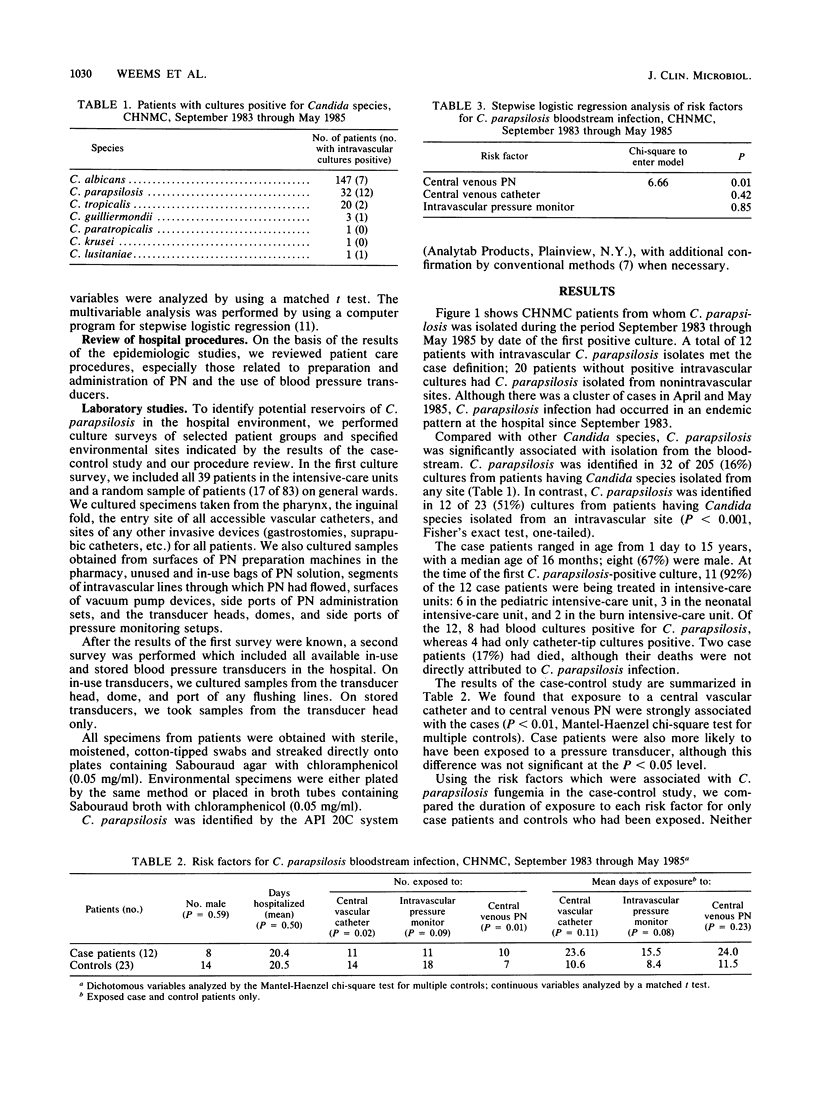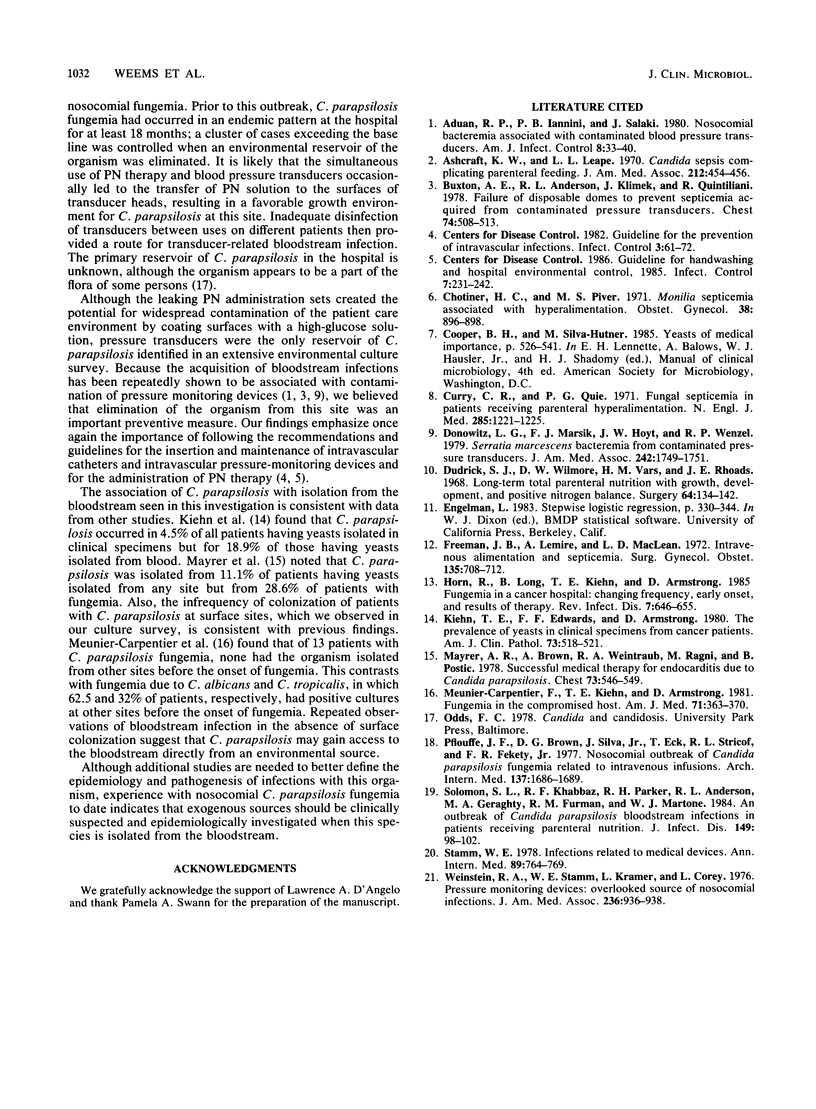Abstract
During the period September 1983 through May 1985, Candida parapsilosis was isolated from intravascular sites (blood or vascular catheter tips) in 12 patients at a pediatric hospital. Of 205 patients with cultures of any site positive for Candida species, 32 (16%) had cultures positive for C. parapsilosis. In contrast, of 23 patients with intravascular cultures positive for Candida species, 12 (51%) had cultures positive for C. parapsilosis (P less than 0.001, Fisher's exact test). The 12 patients with intravascular cultures positive for C. parapsilosis were more likely to have received central venous nutrition therapy (10 of 12 versus 7 of 23; P less than 0.01, Mantel-Haenzel chi-square test) and had a longer duration of exposure to blood pressure transducers (P less than 0.08, paired t test) than the 23 ward- and age-matched controls. C. parapsilosis was isolated from 11 (32%) of 34 in-use and stored blood pressure transducers. After ethylene oxide sterilization of blood pressure transducers was begun, in-use pressure transducers showed no growth of C. parapsilosis. This study emphasizes the role of C. parapsilosis as a nosocomial pathogen associated with invasive devices and parenteral nutrition; it also emphasizes the importance of adhering to recommended procedures for sterilizing blood pressure transducers.
Full text
PDF



Selected References
These references are in PubMed. This may not be the complete list of references from this article.
- Aduan R. P., Iannini P. B., Salaki J. Nosocomial bacteremia associated with contaminated blood pressure transducers: report of an outbreak and a review of the literature. Am J Infect Control. 1980 May;8(2):33–40. doi: 10.1016/s0196-6553(80)80043-5. [DOI] [PubMed] [Google Scholar]
- Ashcraft K. W., Leape L. L. Candida sepsis complicating parenteral feeding. JAMA. 1970 Apr 20;212(3):454–456. [PubMed] [Google Scholar]
- Buxton A. E., Anderson R. L., Klimek J., Quintiliani R. Failure of disposable domes to prevent septicemia acquired from contaminated pressure transducers. Chest. 1978 Nov;74(5):508–513. doi: 10.1378/chest.74.5.508. [DOI] [PubMed] [Google Scholar]
- Chotiner H. C., Piver M. S. Monilia septicemia associated with hyperalimentation. Obstet Gynecol. 1971 Dec;38(6):896–898. [PubMed] [Google Scholar]
- Curry C. R., Quie P. G. Fungal septicemia in patients receiving parenteral hyperalimentation. N Engl J Med. 1971 Nov;285(22):1221–1225. doi: 10.1056/NEJM197111252852203. [DOI] [PubMed] [Google Scholar]
- Donowitz L. G., Marsik F. J., Hoyt J. W., Wenzel R. P. Serratia marcescens bacteremia from contaminated pressure transducers. JAMA. 1979 Oct 19;242(16):1749–1751. [PubMed] [Google Scholar]
- Dudrick S. J., Wilmore D. W., Vars H. M., Rhoads J. E. Long-term total parenteral nutrition with growth, development, and positive nitrogen balance. Surgery. 1968 Jul;64(1):134–142. [PubMed] [Google Scholar]
- Freeman J. B., Lemire A., MacLean L. D. Intravenous alimentation and septicemia. Surg Gynecol Obstet. 1972 Nov;135(5):708–712. [PubMed] [Google Scholar]
- Horn R., Wong B., Kiehn T. E., Armstrong D. Fungemia in a cancer hospital: changing frequency, earlier onset, and results of therapy. Rev Infect Dis. 1985 Sep-Oct;7(5):646–655. doi: 10.1093/clinids/7.5.646. [DOI] [PubMed] [Google Scholar]
- Kiehn T. E., Edwards F. F., Armstrong D. The prevalence of yeasts in clinical specimens from cancer patients. Am J Clin Pathol. 1980 Apr;73(4):518–521. doi: 10.1093/ajcp/73.4.518. [DOI] [PubMed] [Google Scholar]
- Mayrer A. R., Brown A., Weintraub R. A., Ragni M., Postic B. Successful medical therapy for endocarditis due to Candida parapsilosis. A clinical and epidemiologic study. Chest. 1978 Apr;73(4):546–549. doi: 10.1378/chest.73.4.546. [DOI] [PubMed] [Google Scholar]
- Meunier-Carpentier F., Kiehn T. E., Armstrong D. Fungemia in the immunocompromised host. Changing patterns, antigenemia, high mortality. Am J Med. 1981 Sep;71(3):363–370. doi: 10.1016/0002-9343(81)90162-5. [DOI] [PubMed] [Google Scholar]
- Plouffe J. F., Brown D. G., Silva J., Jr, Eck T., Stricof R. L., Fekety F. R., Jr Nosocomial outbreak of Candida parapsilosis fungemia related to intravenous infusions. Arch Intern Med. 1977 Dec;137(12):1686–1689. [PubMed] [Google Scholar]
- Solomon S. L., Khabbaz R. F., Parker R. H., Anderson R. L., Geraghty M. A., Furman R. M., Martone W. J. An outbreak of Candida parapsilosis bloodstream infections in patients receiving parenteral nutrition. J Infect Dis. 1984 Jan;149(1):98–102. doi: 10.1093/infdis/149.1.98. [DOI] [PubMed] [Google Scholar]
- Stamm W. E. Infections related to medical devices. Ann Intern Med. 1978 Nov;89(5 Pt 2 Suppl):764–769. doi: 10.7326/0003-4819-89-5-764. [DOI] [PubMed] [Google Scholar]
- Weinstein R. A., Stamm W. E., Kramer L., Corey L. Pressure monitoring devices. Overlooked source of nosocomial infection. JAMA. 1976 Aug 23;236(8):936–938. doi: 10.1001/jama.236.8.936. [DOI] [PubMed] [Google Scholar]


